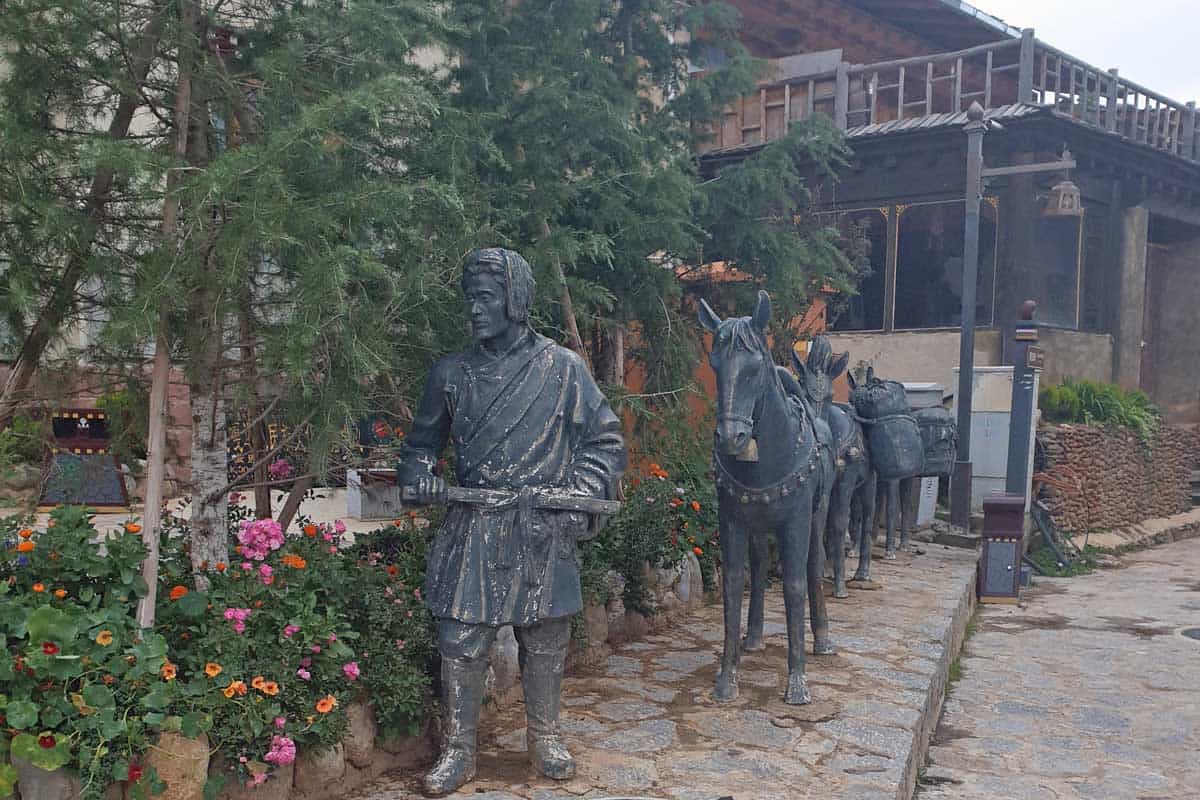Yunnan is one of China’s most diverse and distant provinces, and it has become one of China’s major tourist destinations.
Among its main draws are the cities Dali, Lijiang, and Shangri-la.
The tourist trail along those cities follows the Ancient Tea Horse Road, the trade route that connected Yunnan’s tea-producing lowlands and horse-breeding Tibet – and places farther afield, as well.
Unwittingly, I myself had followed parts of this route during my first year in China, more than a decade ago.
The cities somehow remained places to go even when they were no longer linked by the trade route, but had become part of a backpacker’s route and tourist trail.
Yunnan
As far from Beijing (and other earlier capitals), as one can get in China, Yunnan is among the southern provinces that were long considered the barbarian South.
(Yes, the barbarians aren’t only the Central Asian or ‘Western’/European peoples, they were also ethnic others to the Han Chinese.)
Yunnan is diverse in landscapes, and diverse in its peoples: Of China’s 56 different ethnic groups, 25 can be found in Yunnan (and they make up 38% of the province’s population).
As a distant and diverse region, Yunnan was integrated into the Chinese empire late and with difficulties. Thus, local kingdoms lasted for longer here.
It is also a crossroads.

Neighbors and Connections
Yunnan borders on Myanmar, Laos and Vietnam; Thailand in the tropical south and the Indian Nagaland and Arunachal Pradesh in the Himalayan east are not far.
It reaches from the tropical borderlands adjacent to those countries to karst landscapes in its east. Into the northwest, Yunnan stretches into Tibetan areas of the Himalayas.
There, one finds the “Three Parallel Rivers” area where the Yangtze (here known as the Jinsha) River, the Lancang (Mekong), and the Nujiang (Salween) flow down from their origins in the Himalayas.
The crossroads character of Yunnan is all the stronger because of its trade relations.
For one, there has long been interaction between continental Southeast Asia (Vietnam, Myanmar, Thailand,…) and China, going through Yunnan.
Several ethnic groups have been straddling the border – or rather more usually, living there long before modern borders were ever established.
Trade Networks
Trade and spiritual exchange often went hand-in-hand in East Asia.
Buddhist monks traveled for learning and pilgrimage along trade routes, and merchants were among the greatest benefactors of Buddhist monks and institutions.
Networks of both spanned the area.
The Tea-Horse-Road

The main trade route that has increasingly been talked about is the (Ancient) Tea Horse Road, Cha-Ma Gu Dao 茶马古道.
This trade network connected the tea-producing regions of Yunnan (and Sichuan), especially Pu-er, with Tibet.
The tea, along with salt, was traded up into the Himalayas; horses from the Tibetan highlands, popular for purposes of war, were traded down.
As you can see from the map of the Tea Horse Road above, it was really a network, not just a single route.
Moreover, it spanned not only Yunnan and Tibet, but also had routes going from Chengdu (Sichuan) into Tibet, and routes that connected Yunnan and Tibet with the borderlands of South/Southeast Asia at Bengal and Bangladesh.
Even that might not have been all that the Ancient Tea Horse Road linked. There are suggestions that a route also extended from Lhasa into Southern parts of the Silk Road going through Afghanistan.
In recent decades, the movement of people happening here is not that of traders anymore, but that of tourists.
Major towns on the trade route have now become major tourist spots.
Lijiang
Lijiang is perhaps the best known of the places here, for its relation to the Tea Horse Road, but even more as an ancient town with a very special romantic character.

This center of Naxi culture is very peculiar in its touristy nature, which often makes it less popular among discerning travelers. But, well, there is another side to that.
Actually, the area does not only hold the Lijiang old town, but nearby are the old towns of Baisha and Shuhe, as well.
Further afield towards the guardian mountain of Lijiang and the Naxi peoples, the Yulong Xueshan (Jade Dragon Snow Mountain), one also finds the village of Yuhu, where Joseph Rock lived for much of his time in China.
Dali
Dali, formerly the center of the Bai kingdom, beautifully located between the mountains to the west and the Erhai lake to the east, is another popular place to visit.
Its Three Pagodas, in particular, are a beautiful sight.

And of course, the food in Dali is a draw, as well.
Kunming
Further down the Tea Horse Road, in the center of Yunnan, lies its capital, Kunming. It is usually (if not directly flying to Lijiang) the beginning of a tourist tour.
The city is known as city of eternal spring. Its location gives it a climate that is very comfortable – spring-like – year-round.
This time around, I only had time for a visit to the Zhuangxin “Wet” (really: Farmer Products) Market, but on my search for more knowledge about the chilli in China, that at least was a necessity…
Shangri-la
Going further up north and into the Himalayas past Lijiang, one gets to the town formerly known as Zhongdian – and now Shangri-la.
The strategy behind that name change is only too obvious a marketing ploy.
That notwithstanding, the town is a great place to get to see Tibetan culture – including the Songzanling monastery that is, for good reason, sometimes nicknamed the Little Potala.

One could drive onwards from here towards Lhasa, and get into Tibetan Sichuan. Searching for a special chilli, said to grow as a perennial there, I did get a bit farther along this road.
New Intersections
The mixture of tradition and tourism, preservation and ploy, is all around.
What to make of it, one can discuss far and wide. Or one can go and have a look… or look closer, learn more, in microexploration fashion!


Leave a Reply